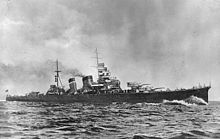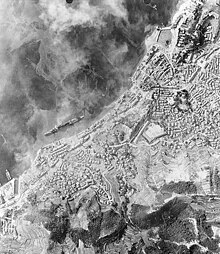Aoba (ship, 1927)
|
Heavy cruiser Aoba 1938
|
||||||||||||||||||
|
||||||||||||||||||
|
||||||||||||||||||
|
||||||||||||||||||
|
||||||||||||||||||
The Aoba ( Japanese 青葉 ) was a heavy cruiser of the Imperial Japanese Navy during World War II. She was the lead ship of the two-ship Aoba class . It was named after Mount Aoba , an extinct volcano near Maizuru in Japan.
Construction and modernizations
The Aoba was on the shipyard of Mitsubishi at Nagasaki laid in January 1924 Kiel. She had been planned as the third ship of the Furutaka class , but several weaknesses in the design had revealed in her two predecessors, so that the plans to build the Aoba and her sister ship Kinugasa were fundamentally revised.
Between 1938 and 1940 the Aoba went back to the shipyard. She received increased anti-aircraft armament and the bridge structure was rebuilt to accommodate new fire control systems. She also received torpedo bulges that widened the hull.
A catapult for the start of seaplanes was immediately behind tower C mounted. The Aoba was able to carry up to two Aichi E13A aircraft in the second half of the Pacific War .
Mission history
Pacific
At the beginning of the Pacific War , the Aoba had the task of supporting various landing efforts by Japanese troops, including the invasions of Guam and Wake in December 1941 and the landings on Rabaul and Kavieng in spring 1942.
Savo Island
Under the command of Vice Admiral Mikawa , the Aoba and four other heavy cruisers penetrated the Sound off Guadalcanal on August 8, 1942 and got into a battle with Allied cruisers. The Aoba ran in second place behind the cruiser Chōkai , which led the formation.
The Aoba gunners scored multiple hits on the enemy cruisers and one of their Type 93 torpedoes hit the USS Quincy .
The cruiser itself received a shell hit and lost one of its reconnaissance aircraft that had taken off before the battle to illuminate the enemy ships with flares.
Cape Esperance
On 11 October 1942, was Aoba as the flagship of Rear Admiral Gotō used to Henderson Field to bomb on Guadalcanal. Together with the Kinugasa and the Furutaka, she encountered a fleet of American heavy cruisers that, already equipped with radar, were firing at the Japanese formation from the dark. The Aoba was hit by 40 shells, which caused severe damage, especially to the superstructure, and destroyed the bridge. Rear Admiral Gotō suffered a fatal wound and around 80 sailors were killed.
The Aoba had to be repaired in Kure from October 22nd to February 13th of the following year . Tower C was removed and a 25 mm triple automatic cannon was put in its place.
While at anchor, the cruiser was surprised by low-approaching B-17 bombers near Kavieng . A 500- lb. - (227-kg) - The aerial bomb exploded on one of the Aoba torpedo tube sets and detonated two Type 93 torpedoes. To prevent sinking from progressive flooding, she had to be beached on April 3rd.
After emergency repairs it ran back to Japan and was not ready for use again until November 1943. She also got tower C back here, which had since been repaired. A Type 21 radar system and two 25mm twin auto cannons were also installed.
Indian Ocean
On March 1, 1944, she ran as the flagship of a Japanese fleet under Rear Admiral Naomasa Sakonju to attack allied merchant shipping in the Indian Ocean . During this attack in the Indian Ocean, the fleet sank the British freighter Behar and took in 104 survivors of the ship, of which 89 were beheaded or shot a few days later on the orders of Rear Admiral Sakonju.
Transport service
In April 1944 the Aoba was assigned to transport operations. From Singapore she brought torpedoes to Penang from the 15th to the 19th . Then she ran out to Davao . She had invited technical personnel to the air base on the island. On April 23, one of the accompanying destroyers, the Amagiri , ran into a magnetic mine in the Strait of Makassar and sank . The survivors were rescued from the Aoba .
In order to be able to defend the strategically important island of Biak with its important airfield against an expected landing by the Allies, more Japanese soldiers were to be relocated there. The Aoba , the light cruiser Kinu and the destroyers Shikinami, Shigure, Uranami, Harusame, Shiratsuyu and Samidare transported soldiers from Palau to Sorong for this operation in May 1944 . The Aoba did not take part in the last part of the mission, the transport to Biak.
Philippines
As part of the Japanese fleets, which were supposed to prevent American troops from landing in the Philippines in October 1944 , the Aoba was reassigned to the 16th Cruiser Division as the flagship of Rear Admiral Sakonju .
The ship did not take part in the sea and air battle in the Gulf of Leyte , but had the task of escorting a convoy of cargo ships with supplies to Mindanao . The convoy carried troops of the 102nd and 30th Infantry Regiments in four fast freighters, which were accompanied by the Aoba , the light cruiser Kinu and a destroyer.
In the early morning of October 23, 1944, at 3:25 a.m. , the Aoba was attacked by the American submarine USS Bream a few nautical miles north-west of Mindoro . From the torpedo compartment of six, one hit the Aoba on starboard, level with the engine rooms. Engine room 2 immediately filled up and the ship turned 15 ° on its starboard side. After her machines failed , she had to be towed from the Kinu to a Japanese repair facility near Manila . Due to radio messages, the Americans knew the anchorage and attacked it with airplanes. However, the cruiser could later be relocated to Japan.
The End
In Japan, the Aoba was then stuck due to a lack of fuel. It was not completely repaired, but anchored as a floating anti-aircraft platform at Kure. She was attacked at her anchorage on July 24 and 28, 1945 by American planes launched from Task Force 38 aircraft carriers .
On the 24th, she was hit by a 500- lb. - (227 kg) bomb hit on the port side level with the waterline at the bow. The explosion tore open the hull and the cruiser absorbed so much water that the forecastle sagged onto the shallow bottom. A heavy bomb just missed the ship and was detonated by its delay detonator below the surface of the water on the port side, next to the side of the Aoba . The result was the filling of the port engine room and, in combination with the counter-flooding initiated by the ship's safety and the slow filling of a starboard engine room through leaky bulkheads , the ship sagging from the bow to the center of the ship to the bottom.
The crew initially stayed on board, but only the 25-mm anti-aircraft guns, which did not require electricity from the engine rooms, were still functioning.
On July 28, four more bombs hit the ship and caused such severe damage, especially aft, that the Aoba sank to the seabed over the entire length of the ship.
The surviving crew members finally disembarked after the attacks on the 28th.
wreck
The wreck of the Aoba was scrapped after the war.
Evidence and references
Remarks
- ↑ for 1939 according to Japanese Cruisers of the Pacific War. P. 806 - Construction dates before modernization are described in the class article.
- ↑ contains a staff division of about 30 men, as described in Japanese Cruisers of the Pacific War. P. 259.
literature
- Eric LaCroix, Linton Wells: Japanese Cruisers of the Pacific War. US Naval Institute Press, 1997, ISBN 0-87021-311-3 .
- Furutaka class / Aoba class. Gakken Pacific War Series, number 44, Gakken, Tokyo, 2003, ISBN 4056033234 .
- HP Willmott: The battle of Leyte Gulf: the last fleet action. Indiana University Press, 2005, ISBN 0253345286 .
- Malcolm H. Murfett: Naval warfare 1919–45: an operational history of the volatile war at sea. Routledge, 2008, ISBN 0415458048 .
- Paul S. Dull: A battle history of the Imperial Japanese Navy, 1941-1945. US Naval Institute Press, 2007, ISBN 1591142199 .
Web links
Individual evidence
- ^ A battle history of the Imperial Japanese Navy, 1941-1945. P. 302.
- ^ The battle of Leyte Gulf: the last fleet action. P. 269.
- ↑ Naval warfare 1919-45: an operational history of the volatile war at sea. P. 380.
- ↑ Aoba on combinedfleet.com, viewed September 8, 2010
- ^ The battle of Leyte Gulf: the last fleet action. Pp. 100, 101.
- ↑ REPORTS OF THE US NAVAL TECHNICAL MISSION TO JAPAN 1945–1946, S-06-1, Reports of Damage to Japanese Warships-Article 1, p. 26.



